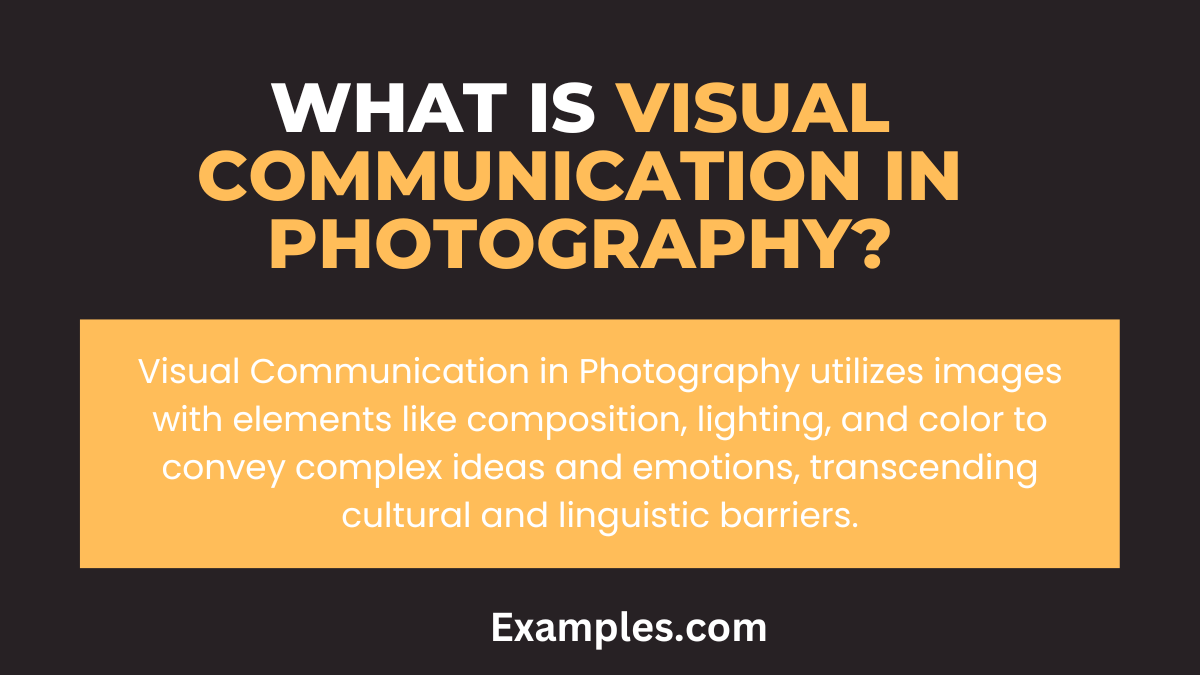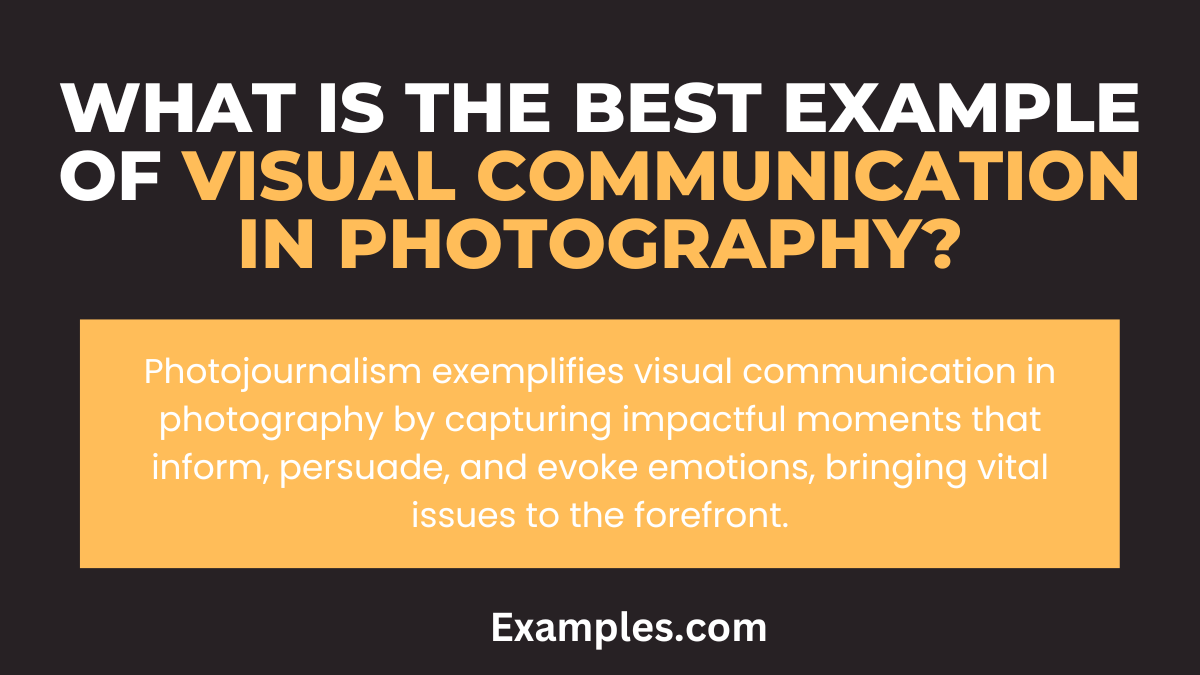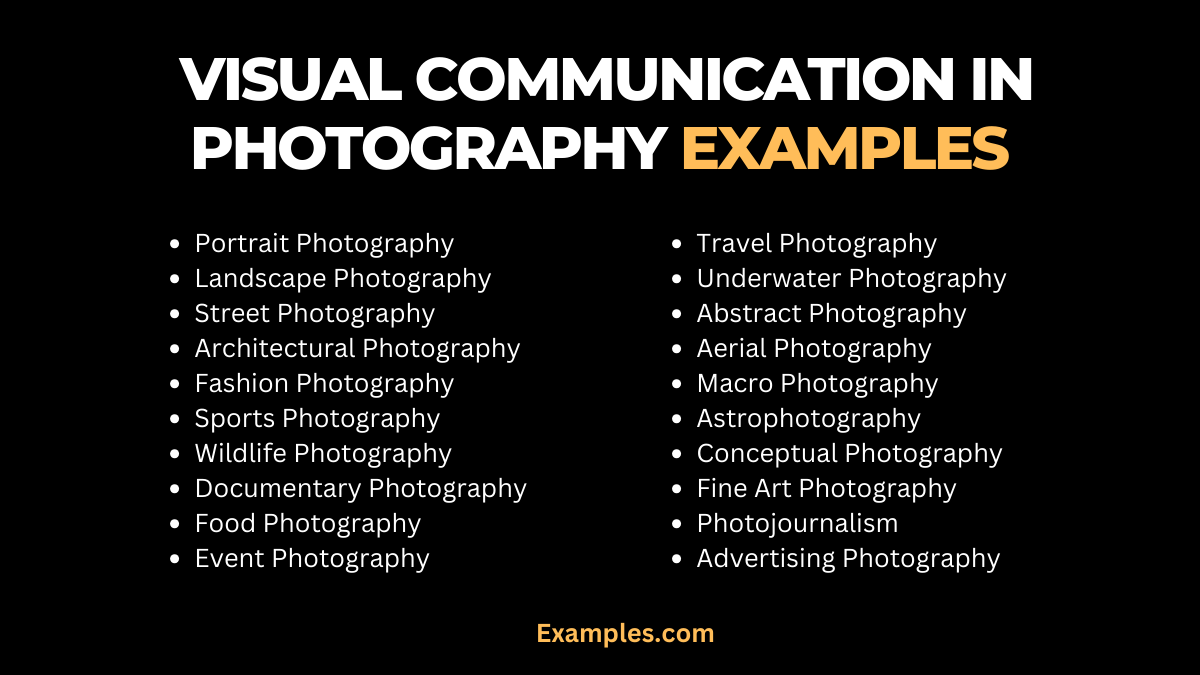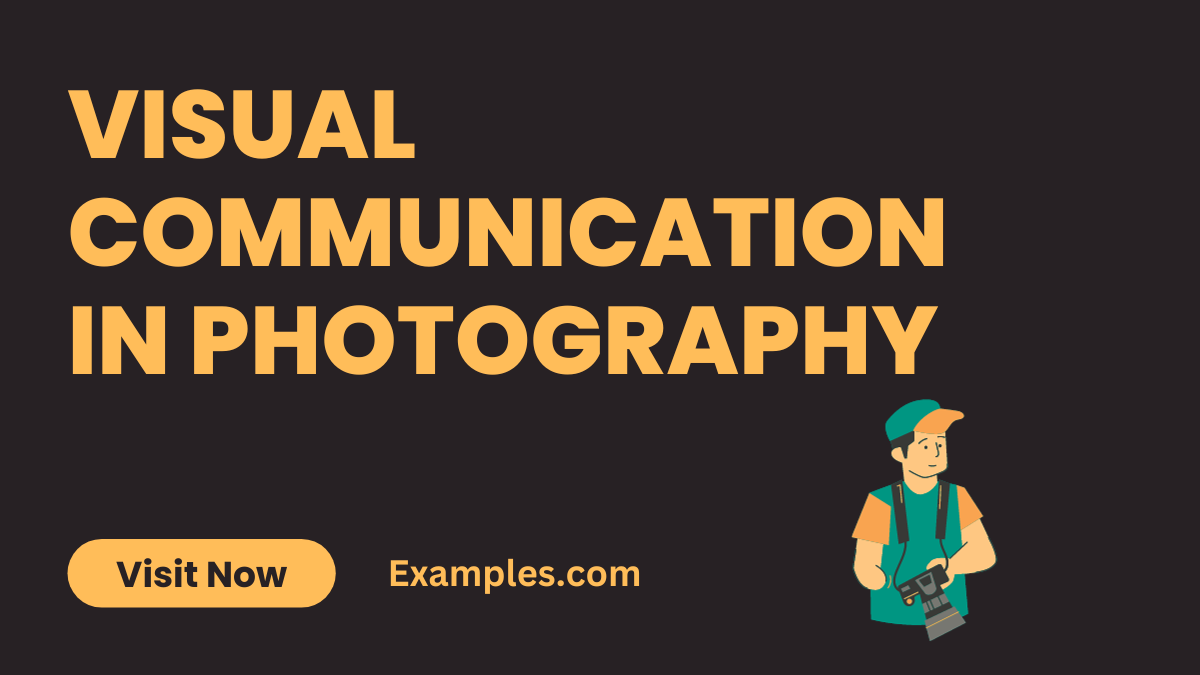19+ Visual Communication in Photography Examples
“Visual Communication in Photography – Complete Guide with Examples” delves into the art of conveying messages through imagery. This comprehensive guide explores various Communication Examples, demonstrating how photography transcends mere visuals to become a powerful communicative tool. From the subtleties of composition to the emotional resonance of color, each example illuminates the nuances of visual storytelling. Ideal for both novices and seasoned photographers, this guide offers insights into crafting visually compelling narratives that speak volumes without words.
Download Types of Visual Communication in Photography PDF
What is Visual Communication in Photography?

Visual Communication in Photography is the practice of using images to convey information, ideas, or feelings. It’s not just about taking a picture, but about using visual elements like composition, lighting, and color in a way that communicates a message or emotion. This type of communication is essential in photography because it allows the photographer to convey complex ideas and emotions that might be difficult to express through words alone. It’s a powerful tool that can transcend cultural and linguistic barriers, making it a universal language.
What is the Best Example of Visual Communication in Photography?

An outstanding example of Visual Communication in Photography is photojournalism. This genre uses photography to tell news stories, capturing moments that communicate the realities of world events, societal issues, or cultural phenomena. For instance, a photojournalist might capture a poignant moment in a protest or a touching scene in the aftermath of a natural disaster. These images are more than just snapshots; they are visual narratives that inform, persuade, and evoke emotional responses. Through photojournalism, photographers utilize their Visual Communication Skills to bring important issues to the forefront, making it an influential form of Visual Communication in the Media.
20 Visual Communication in Photography Examples

Visual communication in photography is a pivotal aspect of modern visual media, blending artistry and message to convey powerful narratives. This field encompasses a range of Visual Communication Examples, each employing distinct Types of Visual Communication to tell a story or present an idea. From the pages of a Visual Communication Journal to the expansive world of Visual Communication in Photography, these examples highlight the Importance of Visual Communication. Mastering these techniques not only enhances Visual Communication Skills but also opens diverse career paths in Visual Communication Jobs, Careers, Salaries.
- Portrait Photography: Captures individual personalities, conveying emotions and stories.
- Landscape Photography: Showcases nature’s beauty, often highlighting environmental messages.
- Street Photography: Captures everyday life, reflecting societal trends and cultures.
- Architectural Photography: Showcases buildings and structures, emphasizing design aesthetics.
- Fashion Photography: Communicates style and trends through creative imagery.
- Sports Photography: Captures the energy and dynamics of sporting events.
- Wildlife Photography: Highlights natural habitats and raises conservation awareness.
- Documentary Photography: Tells real-life stories, often focusing on social issues.
- Food Photography: Uses aesthetics to make food appealing and desirable.
- Event Photography: Documents occasions, capturing key moments and emotions.
- Travel Photography: Explores different cultures and landscapes, promoting exploration.
- Underwater Photography: Reveals the mysteries of aquatic life and environments.
- Abstract Photography: Uses shapes and colors to convey artistic concepts.
- Aerial Photography: Offers a unique perspective, often for surveying or art.
- Macro Photography: Focuses on small subjects, revealing intricate details.
- Astrophotography: Captures celestial events and the night sky’s beauty.
- Conceptual Photography: Uses symbolism and ideas for artistic expression.
- Fine Art Photography: Emphasizes artistic vision and personal style.
- Photojournalism: Communicates news and stories through impactful images.
- Advertising Photography: Creates images specifically designed to sell products.
What are the Types of Visual Communication in Photography?

In the realm of Visual Communication in Photography, understanding the various types is essential to mastering the art. Each type utilizes unique Visual Communication Skills to convey messages and emotions:
- Documentary Photography: This type captures real-life events or environments to tell stories or highlight issues. It’s a powerful form of Visual Communication in the Media, often used in photojournalism.
- Portrait Photography: Here, the focus is on capturing the personality and emotions of individuals, making it a profound example of Visual Communication Examples.
- Landscape Photography: Landscape photographers communicate the beauty or plight of natural environments, playing a significant role in environmental Visual Communication.
- Street Photography: This spontaneous style captures everyday life, reflecting societal trends and cultures, and is a dynamic Type of Visual Communication.
- Architectural Photography: Focusing on buildings and structures, this type emphasizes design and form, showcasing the Characteristics of Visual Communication through built environments.
- Fine Art Photography: Here, the photographer’s vision and concept are paramount, often used to express complex artistic ideas and emotions.
- Fashion Photography: A tool in commercial and advertising sectors, it combines aesthetics and style, illustrating How to Use Visual Communication effectively in marketing.
- Macro Photography: It reveals the intricate details of small subjects, providing a unique perspective and showing How Visual Communication Works on a micro level.
- Astrophotography: Capturing celestial bodies and events, this type showcases the wonders of the universe, a stellar example of Visual Communication in Photography.
- Conceptual Photography: This type is focused on conveying an idea or message through staged and planned imagery, making it a creative and thought-provoking Visual Communication Example.
How Does Photography Contribute to Visual Communication?
Photography is a powerful medium in Visual Communication, offering a unique blend of artistry and clarity that can convey complex ideas and emotions instantly and universally. It’s an essential tool in Visual Communication in Photography, where images are used to express, inform, and influence.
- Capturing Emotions and Narratives: Photography excels in capturing and conveying emotions, often telling a story in a single frame. This aspect is crucial in Visual Storytelling in Photos, where the narrative is as important as the visual appeal.
- Transcending Language Barriers: One of the key Characteristics of Visual Communication is its ability to transcend language and cultural barriers. Photography achieves this by using universal visual cues that are easily understood by diverse audiences.
- Enhancing Information Retention: Visuals are processed faster and retained longer than text. Visual Communication Examples in photography, like infographics and educational diagrams, utilize this aspect to enhance learning and understanding.
- Influencing Perceptions and Opinions: Photography has the power to shape public opinion, evident in fields like Visual Communication in the Media and photojournalism. It can bring attention to social issues, influence political discourse, and drive social change.
- Educational and Professional Development: In educational settings, Visual Communication Journals and textbooks with photographic content enrich learning. Professionally, Visual Communication Skills are enhanced through photography, expanding career opportunities in fields like advertising, journalism, and digital marketing.
- Artistic Expression and Commercial Use: Photography is a tool for artistic expression, allowing photographers to explore and present their unique perspectives. Commercially, it’s used in advertising and marketing, where Visual Communication is key to brand messaging and product presentation.
Photography’s contribution to Visual Communication is multifaceted, impacting areas from education and professional development to media and advertising. Its ability to capture reality, convey complex information, and evoke emotional responses makes it an invaluable tool in the arsenal of visual communication.
What is the Role of Photographic Images in Visual Communication?
Photographic images play a central role in Visual Communication, particularly in the realm of Visual Communication in Photography. These images are more than just snapshots; they are a powerful medium for storytelling, conveying emotions, and sharing information.
- Storytelling: Photographic images tell stories. Whether in photojournalism, where photographers capture significant moments to narrate a news story, or in advertising, where images are used to create compelling narratives about products.
- Conveying Emotions: Photographs have the unique ability to evoke a range of emotions. A well-composed image can inspire joy, sorrow, wonder, or empathy, making it an effective tool in Visual Communication.
- Sharing Information: In the age of digital media, photographic images are a primary means of sharing information. They are used extensively in Visual Communication in the Media, educational materials, and corporate communications.
- Cultural Representation: Photographs often reflect cultural and societal norms. They are a window into diverse cultures and lifestyles, helping to broaden understanding and appreciation across different communities.
- Promoting Engagement: In today’s fast-paced world, images are more likely to capture attention than blocks of text. This makes photographic images crucial in marketing and advertising, where engagement is key.
- Educational Tool: In educational settings, photographs are used to illustrate complex concepts, making learning more engaging and effective. This aligns with various Types of Visual Communication used in academia.
- Enhancing Business Communications: In business, images are used to enhance reports, presentations, and marketing materials, making them more appealing and easier to understand.
- Career Opportunities: The growing importance of images in communication has led to a rise in Visual Communication Jobs, Careers, Salaries. Photography as a career is more relevant than ever, with numerous opportunities in different sectors.
What is Visual Language in Photography?
Visual language in photography refers to the way images communicate ideas or emotions through composition, light, and subject matter, transcending traditional language barriers.
How is Visual Communication Used in Photography?
Visual communication in photography is used to convey messages, tell stories, and evoke emotions through strategic combinations of visual elements like light, color, and composition.
What Makes Photography a Powerful Communication?
Photography is a powerful medium of communication due to its ability to capture and convey complex ideas, emotions, and narratives instantly, resonating deeply with viewers.
In conclusion, Visual Communication in Photography is not just an artistic endeavor but a powerful tool for storytelling, education, and awareness. It transcends the mere act of capturing images, elevating photography to a medium through which complex narratives and emotions are conveyed. From the subtleties of portrait photography to the broad strokes of landscape and documentary genres, each style contributes uniquely to how we perceive and interact with our world.
For those interested in exploring this field further, Grand Valley State University Libraries offer an excellent resource that delves deeper into the intricacies of visual communication in photography (GVSU Libraries: Visual Communication in Photography). Additionally, the Lawrence Berkeley National Laboratory’s Creative Services team provides a fascinating look at how photography can be used effectively in various professional settings (LBNL Creative Services: Photography). Both resources are invaluable for anyone looking to enhance their understanding and skill in using photography as a form of visual communication.



